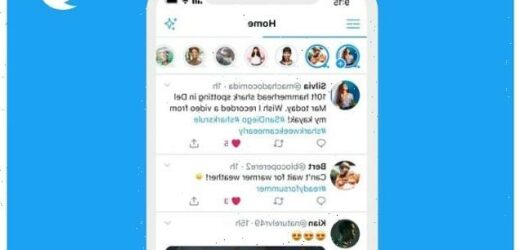Twitter kills Fleets – its rival to Snapchat – after admitting no one used it
- Twitter debuted the ‘disappearing tweet’ feature in November 2020
- Fleets couldn’t be retweeted or receive public responses, but had to be interacted with through Direct Messages
- The company conceded the feature failed to gain traction with users
- Twitter will officially pull the plug on Fleets on August 3
Twitter has announced it’s shutting down Fleets, the disappearing-tweet feature it launched last year to compete with Snapchat and Instagram Stories.
The company will pull the plug on the option on August 3 after it failed to gain traction with users.
Fleets’ time on the platform was short-lived: Twitter began testing the feature in March 2020 and rolled it out globally in November of that year.
It had just begun testing advertising within the feature last month.
In a blog post on Wednesday, Ilya Brown, Twitter’s head of product, brand and video ads, said users hadn’t taken to the option the way the company had predicted.
‘We built Fleets as a lower-pressure, ephemeral way for people to share their fleeting thoughts,’ Brown said.
‘We hoped Fleets would help more people feel comfortable joining the conversation on Twitter. But, in the time since we introduced Fleets to everyone, we haven’t seen an increase in the number of new people joining the conversation with Fleets like we hoped.’
Scroll down for video
Twitter will pull the plug on its ‘disappearing tweet’ feature, Fleets, on August 3, just eight months after it launched globally. ‘We haven’t seen an increase in the number of new people joining the conversation with Fleets like we hoped,’ said Twitter’s Ilya Brown
Brown said the company is always trying to improve and some updates ‘are speculative and won’t work out.’
‘We’re evolving what Twitter is, and trying bigger, bolder things to serve the public conversation,’ he added.
‘If we’re not evolving our approach and winding down features every once in a while – we’re not taking big enough chances.’
Available for iOS and Android devices, Fleets – a portmanteau of ‘fleeting’ and ‘tweet’ – couldn’t be retweeted or receive public responses, but instead had to be interacted with through Direct Messages.
Fleets which rolled out in November, was Twitter’s attempt at competing with Snapchat and Instagram Stories. It gave users the option to comment in a more private way, sharing casual thoughts, opinions, and feelings
Followers could reply to Fleets by sending a private Direct Message, but only if they followed each other or the account holder had their Direct Messages set to open.
The feature, which was successfully trialed in Brazil and other countries before going worldwide, gave users the option to tweet about things in a more private way, with the idea it would cut back on harassment by strangers on the platform.
In trials, Fleets seemed to make people feel more comfortable sharing personal and casual thoughts, opinions, and feelings.
Twitter executives admitted at launch that the format ‘may sound familiar’, referring to Snapchat, which spearheaded the art of disappearing messages, and Instagram, which followed suit in with Stories 2016.
Twitter users could choose to post photos, videos and reactions to Fleets
In November 2020, Facebook-owned WhatsApp also launched ‘disappearing messages’ that vanish from chats after seven days.
The news of Fleets’ demise comes one day after Twitter rolled out a new feature allowing users to choose who can reply to a tweet even after it’s been sent.
The San Francisco-based media giant has been experimenting with its reply control function at least since May 2020.
Now all users can select who can reply to their live tweets—people specifically tagged in a tweet, the user’s followers, or any Twitter user.
People who can’t reply will still be able to view, retweet, retweet with Comment, and ‘like’ posts.
The company described the reply control settings as transforming Twitter threads into ‘conversations’ that would enable users to ‘feel safer Tweeting and have more meaningful conversations.’
Source: Read Full Article





